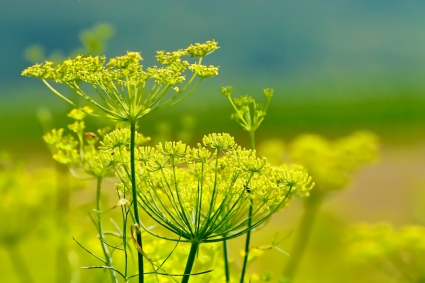How to recognize it ?
Fennel has the Latin name of Foeniculum vulgare. It is also called officinal fennel and common fennel.

Fast growing, fennel can form very nice light and airy clumps. It likes light, rich and deep soils. It is both hardy and drought resistant. It can be sown either in the spring in a nursery, or in the fall, directly in place from the last harvest of the seeds.
Fennel is a perennial and aromatic plant that can grow up to more than 2 m high with a full sun exposure. It can withstand temperatures as low as -15 degrees Celsius (°C) or 258.1 Kelvin (K).
The leaves are finely cut while the flowers are small, yellow and grouped in umbels. They appear from July to September. The fruits are elongated and have a sweet smell, close to anise. It has a big root.
How to grow it ?
- It should not be planted too close to the dill with which it hybridises easily;
- Shelf life of seeds : 4 years;
- Sowing : under frame in boxes;
- Transplanting : in cups with 2 true leaves, proceed delicately;
- Planting : late spring, plants are about 10 centimeters (4 inches);
- Sowing : in spring, spaced 20 centimeters (8 inches) apart, thin to 60 centimeters (24 inches), when plants have 4 leaves;
- Emergence : about 20 days;
- Distance between plants : at least 60 centimetres (24 inches);
- Maintenance : cut the stems low to the ground at the end of winter;
- Multiplication : seedling ;
- Soil : light, humus and drained;
- Composting requirements : at planting;
- Mulching : in summer to maintain freshness;
- Water requirements : low but regular and in case of prolonged drought.
How to harvest it ?
Seeds are harvested in early autumn, as soon as they turn yellow, as they ripen in stages.

One cuts the umbel which one lets dry with the air during 3 days, then one recovers seeds (by beating them on a fabric) which one puts to dry again before storing them. The dry seeds are used in can also infusions and in kitchen. One chews after a copious meal. The leaves, to collect before the bloom of the plant, can also be dried for a condimentary use (broths, fish).
The medicinal virtues

- Fennel is beneficial in digestive disorders, stomach pains, abdominal spasms, bloating and flatulence;
- The fennel is very effective in the form of herb tea to increase the volume of maternal milk;
- It also acts gently on the muscular spasms of the infant;
- But Attention with the essential oil of fennel : it can prove to be toxic for the nervous system at the time of the exceeding of certain doses.
Updated on 10 February 2023 at 18:09







